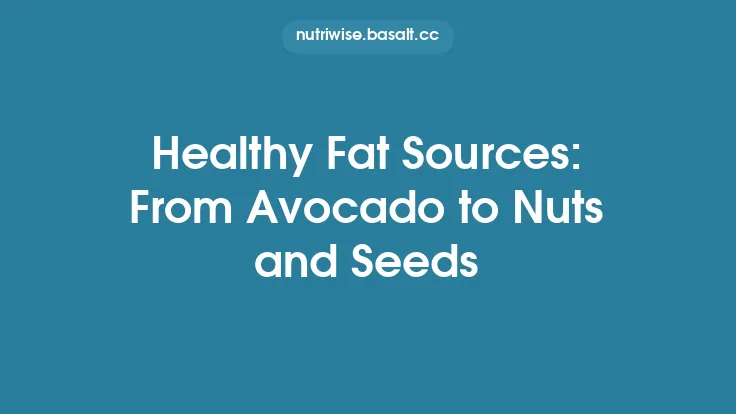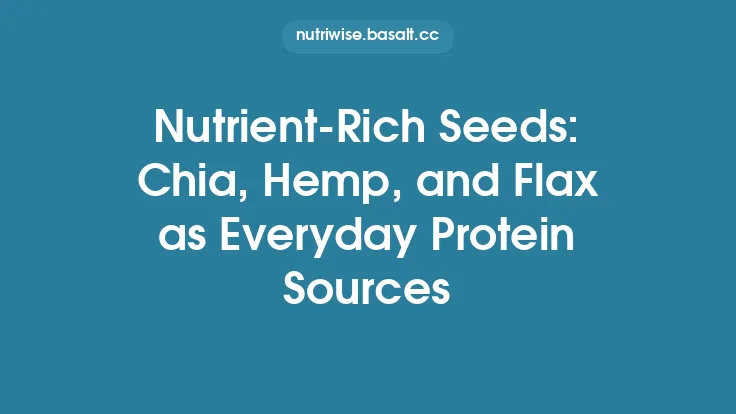Incorporating fiber‑rich add‑ins such as seeds, nuts, and legume flours into baked treats is a powerful way to boost nutrition without sacrificing the pleasure of a good bite. While the classic approach to healthier baking often focuses on swapping out refined flours or reducing sugar, the strategic use of these high‑fiber ingredients can simultaneously improve texture, flavor, and shelf life. Below is a comprehensive guide that walks you through the science, practical techniques, and creative ideas for making your muffins, breads, cookies, and bars both delicious and fiber‑dense.
Why Fiber Matters in Baked Goods
1. Types of dietary fiber
- Soluble fiber (e.g., β‑glucan, pectin, gums) dissolves in water to form a gel‑like substance. It slows gastric emptying, moderates blood glucose spikes, and can lower LDL cholesterol.
- Insoluble fiber (e.g., cellulose, hemicellulose, lignin) adds bulk, promotes regular bowel movements, and contributes to a feeling of fullness.
2. Functional benefits for baking
- Moisture retention: Both soluble and insoluble fibers bind water, helping baked goods stay soft longer.
- Structure support: Fine ground nuts or legume flours can partially replace gluten’s network, providing a tender crumb.
- Flavor development: Many seeds and nuts contain natural oils and aromatic compounds that enhance the Maillard reaction, giving a richer crust and deeper flavor.
3. Health impact
- Increased satiety → potential for lower overall caloric intake.
- Improved gut microbiota through prebiotic fibers (e.g., in chia and flax).
- Reduced post‑prandial glucose response, beneficial for metabolic health.
Overview of Fiber‑Rich Add‑Ins
| Category | Representative Ingredients | Key Fiber Content (per 100 g) | Notable Nutrients |
|---|---|---|---|
| Seeds | Flaxseed (ground), Chia, Hemp, Pumpkin, Sunflower | 27–35 g | Omega‑3 (ALA), lignans, magnesium |
| Nuts | Almonds, Walnuts, Pistachios, Pecans, Hazelnuts | 10–12 g | Vitamin E, monounsaturated fats, phytosterols |
| Legume Flours | Chickpea, Lentil, Yellow pea, Soy | 15–25 g | Protein, iron, B‑vitamins, resistant starch |
*Tip:* Whole seeds retain the most fiber but may be harder to integrate into delicate batters. Grinding (e.g., using a coffee grinder for flax or a food processor for nuts) improves dispersion and bioavailability.
Technical Foundations: How These Ingredients Interact with Dough and Batter
1. Water Absorption Capacity (WAC)
- Seeds (especially chia and flax) can absorb up to 12 × their weight in water, forming a gel. This property is useful for replacing eggs or adding extra moisture to gluten‑free or low‑fat recipes.
- Legume flours have a moderate WAC (≈1.5–2 g water per g flour). They contribute to batter viscosity, which can affect leavening.
Practical implication: When adding 30 g of ground flaxseed, increase the liquid component by roughly 180 g (≈¾ cup) to maintain batter consistency.
2. Oil Absorption Capacity (OAC)
- Nuts possess high OAC due to their natural lipids, which helps retain butter or oil flavor while reducing the need for added fats.
- Hemp seeds have a balanced OAC, making them ideal for both moisture and flavor without overly greasing the crumb.
Practical implication: Substituting 20 % of wheat flour with finely ground almonds can reduce the required butter by 10 % while preserving richness.
3. Particle Size and Texture
- Coarse ground nuts (≈500 µm) add crunch and a rustic mouthfeel, perfect for crumbly cookies or granola bars.
- Fine milled legume flours (≤150 µm) blend seamlessly into batters, yielding a uniform crumb similar to wheat flour.
Practical implication: For a light, airy muffin, keep legume flour particle size small; for a crunchy cookie, retain a larger nut grind.
4. Impact on Gluten Development
- Legume flours are gluten‑free, so they dilute the gluten network when mixed with wheat flour. This can lead to a softer crumb but may reduce rise if not compensated.
- Seeds and nuts do not contain gluten; however, their water‑binding gels can interfere with gluten strand formation if added in excess.
Balancing act: Limit total non‑gluten fiber add‑ins to ≤30 % of the flour weight for recipes that rely heavily on gluten for structure (e.g., yeasted breads). For quick breads and cakes, higher percentages are acceptable.
Step‑by‑Step Integration Strategies
A. Seed Gels as Egg Replacers
- Prepare the gel: Combine 1 part ground flaxseed or chia seeds with 2.5 parts warm water. Let sit 5–10 minutes until thickened.
- Incorporate: Replace each egg with 1 Tbsp of gel plus 1 Tbsp of oil (optional for extra richness).
- Adjust leavening: Add an extra ¼ tsp of baking powder per egg replaced to compensate for the reduced aeration.
*Best for:* Vegan banana bread, oat muffins, and quick‑rise scones.
B. Nut Flour Substitution Ratios
| Target Flour | Recommended Nut Flour Substitution |
|---|---|
| Wheat flour (all‑purpose) | Up to 20 % (e.g., replace 40 g of 200 g flour) |
| Whole‑grain flour | Up to 30 % (e.g., replace 60 g of 200 g flour) |
| Gluten‑free flour blend | Up to 40 % (e.g., replace 80 g of 200 g blend) |
Method:
- Sift nut flour with the remaining dry ingredients to avoid clumping.
- Reduce the total liquid by 5–10 % because nut flours retain less water than wheat flour.
- Increase the fat slightly (1 Tbsp per ¼ cup nut flour) if the final product feels dry.
C. Legume Flour Integration
- Start low: Replace 10 % of the base flour with legume flour, then increase in 5 % increments after testing texture.
- Pre‑hydrate: Mix legume flour with a portion of the liquid and let rest 10 minutes (a “roux‑like” slurry). This reduces the gritty mouthfeel.
- Flavor pairing: Chickpea flour works well with savory herbs; lentil flour pairs nicely with spices like cumin and coriander in flatbreads.
D. Whole‑Seed Add‑Ins for Crunch
- Timing: Fold seeds (pumpkin, sunflower, sesame) into the batter after the wet and dry components have been combined to avoid premature gelatinization.
- Quantity: 1–2 Tbsp per cup of flour adds crunch without overwhelming the crumb.
- Toasting: Lightly toast seeds (3–5 minutes at 350 °F) to enhance nutty aroma and reduce raw bitterness.
Recipe Illustrations
1. High‑Fiber Blueberry Lemon Muffins
Dry mix:
- 150 g all‑purpose flour
- 30 g almond flour (20 % substitution)
- 20 g chickpea flour (10 % substitution)
- 30 g ground flaxseed (gel)
- 2 tsp baking powder
- ½ tsp baking soda
- ¼ tsp salt
Wet mix:
- 120 ml almond milk (or any plant milk)
- 60 ml olive oil
- 2 Tbsp honey (optional)
- Zest of 1 lemon
Add‑ins:
- 100 g fresh blueberries (tossed in a little flour)
- 1 Tbsp chia seed gel (prepared as 1 Tbsp chia + 2½ Tbsp water)
Method:
- Whisk dry ingredients together.
- In a separate bowl, combine wet ingredients and flaxseed gel; let sit 5 min.
- Fold wet into dry, then gently fold in blueberries and chia gel.
- Portion into a muffin tin (¾ full) and bake at 375 °F for 18–20 minutes.
*Result:* Moist crumb, subtle nutty undertone, and a fiber boost of ~9 g per muffin.
2. Savory Chickpea‑Flax Flatbread
Ingredients:
- 120 g chickpea flour
- 30 g ground flaxseed
- 1 tsp dried rosemary
- ½ tsp sea salt
- 180 ml warm water
- 2 Tbsp olive oil
Procedure:
- Mix dry ingredients; create a well and pour in water and oil.
- Stir until a thick batter forms; let rest 10 minutes (flax gel develops).
- Heat a non‑stick skillet over medium heat; spoon ¼ cup batter, spread thin.
- Cook 2–3 minutes per side until golden.
*Result:* A crisp, fiber‑dense flatbread perfect for topping with hummus or avocado.
3. Pumpkin‑Seed & Walnut Chocolate Chip Cookies
Dry mix:
- 180 g whole‑wheat flour
- 30 g finely ground walnuts (≈15 % substitution)
- 1 tsp baking soda
- ½ tsp salt
Wet mix:
- 100 g coconut oil (softened)
- 80 g maple syrup
- 1 tsp vanilla extract
Add‑ins:
- 30 g roasted pumpkin seeds (coarsely chopped)
- 60 g dark chocolate chips
- 1 Tbsp chia gel (1 Tbsp chia + 2½ Tbsp water)
Method:
- Cream coconut oil and maple syrup; blend in chia gel.
- Combine wet with dry, then fold in seeds and chocolate.
- Scoop onto a parchment sheet, flatten slightly.
- Bake at 350 °F for 12–14 minutes.
*Result:* Chewy cookies with a satisfying crunch and ~6 g fiber per serving.
Troubleshooting Common Issues
| Symptom | Likely Cause | Fix |
|---|---|---|
| Dry, crumbly texture | Too much high‑absorption fiber (e.g., excess flax or chia) without enough liquid. | Increase liquid by 10–15 % or add a small amount of yogurt/kefir for extra moisture. |
| Dense, heavy crumb | Over‑use of legume flour diluting gluten; insufficient leavening. | Reduce legume flour to ≤30 % of total flour; add an extra ¼ tsp baking powder per ¼ cup legume flour. |
| Bitter aftertaste | Unroasted nuts or seeds, or over‑grinding (producing bitter oils). | Lightly toast nuts/seeds; store ground nuts in the freezer to limit oxidation. |
| Uneven rise | Seed gels not fully hydrated before mixing. | Allow gels to sit 10 minutes; pre‑hydrate legume flour slurries. |
| Excessive spreading (cookies) | High fat from nuts/seeds combined with low protein structure. | Add a tablespoon of oat flour or a small amount of wheat flour to increase structure. |
Nutritional Spotlight: Fiber Types in Common Add‑Ins
| Ingredient | Soluble Fiber (g/100 g) | Insoluble Fiber (g/100 g) | Additional Health Highlights |
|---|---|---|---|
| Ground Flaxseed | 5.5 | 20.0 | Lignans (phytoestrogen), α‑linolenic acid |
| Chia Seeds | 6.0 | 23.0 | Omega‑3, calcium, antioxidants |
| Hemp Seeds | 1.5 | 4.0 | Gamma‑linolenic acid, complete protein |
| Almond Meal | 2.0 | 10.0 | Vitamin E, magnesium |
| Chickpea Flour | 8.0 | 12.0 | Folate, iron, resistant starch |
| Lentil Flour | 7.5 | 10.5 | B‑vitamins, potassium |
*Takeaway:* By mixing ingredients with complementary soluble/insoluble ratios, you can tailor the glycemic impact and satiety profile of each baked product.
Storage and Shelf Life Considerations
- Ground nuts and seeds oxidize quickly. Store in airtight containers in the refrigerator (up to 3 months) or freezer (up to 6 months).
- Legume flours have a shorter shelf life than refined flours due to higher fat content. Keep in a cool, dark place and use within 2–3 months after opening.
- Pre‑made seed gels (flax or chia) can be prepared in bulk and refrigerated for up to 5 days; freeze in ice‑cube trays for longer storage.
- Baked goods with high fiber tend to retain moisture longer, extending freshness by 1–2 days compared to low‑fiber counterparts. For optimal texture, wrap in parchment and store at room temperature; for longer storage, freeze and reheat gently.
Allergen Awareness and Substitution Options
- Tree nuts (almonds, walnuts, pistachios) are common allergens. Substitute with sunflower seed meal (nut‑free, similar texture) or pumpkin seed flour for comparable protein and fiber.
- Legume flours may trigger sensitivities in individuals with legume allergies. Quinoa flour or oat bran can serve as alternative high‑fiber, gluten‑free options.
- Seed gels are generally well tolerated, but chia can cause digestive discomfort in large amounts; limit to ≤2 Tbsp per serving for sensitive individuals.
Frequently Asked Questions
Q1: Can I use whole seeds instead of ground ones?
A: Whole seeds contribute crunch but provide less accessible fiber and can create a gritty texture. For maximum fiber benefit, grind seeds (especially flax) into a fine meal before adding to the batter.
Q2: Will adding a lot of fiber make my bread too dense?
A: Excessive fiber can impede gluten development and gas retention, leading to a denser loaf. Balance fiber add‑ins with strong leavening agents and consider a higher hydration level (up to 80 % of flour weight) to keep the crumb airy.
Q3: How do I know if my baked treat has enough moisture after adding fiber?
A: Perform the “finger test”: press a finger lightly into the cooled product. If it springs back slowly, moisture is adequate. If it feels dry or cracks, increase liquid or add a small amount of yogurt, applesauce, or additional seed gel.
Q4: Are there any special equipment needs?
A: A good-quality coffee grinder or high‑speed blender for nuts/seeds, a kitchen scale for precise ratios, and a fine-mesh sieve for sifting legume flours are the most helpful tools.
Q5: Does high fiber affect the browning of baked goods?
A: Yes. Soluble fibers can retain moisture on the surface, slightly delaying Maillard browning. Counteract by increasing oven temperature by 10–15 °F or extending bake time by a couple of minutes, watching closely to avoid over‑darkening.
Final Thoughts
Integrating seeds, nuts, and legume flours into baked treats is more than a nutritional upgrade; it’s a versatile toolkit for bakers seeking texture, flavor, and functional benefits. By understanding each ingredient’s water and oil absorption capacities, adjusting liquid ratios, and respecting the limits of gluten dilution, you can craft muffins that stay moist for days, breads that rise beautifully, and cookies that deliver a satisfying crunch—all while delivering a substantial boost of dietary fiber.
Experiment with combinations—perhaps a pumpkin‑seed‑infused banana loaf with a swirl of almond‑flour batter, or a chocolate‑chip cookie that marries chia gel with toasted walnut crumbs. The possibilities are endless, and the health dividends are lasting. Happy baking!





